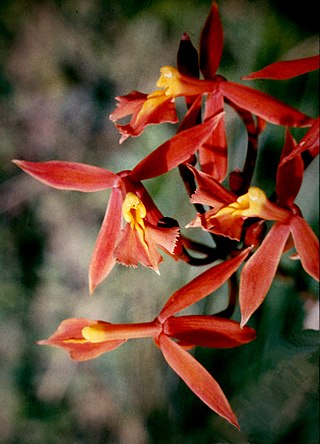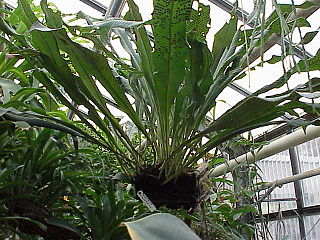
In vascular plants, the roots are the organs of a plant that are modified to provide anchorage for the plant and take in water and nutrients into the plant body, which allows plants to grow taller and faster. They are most often below the surface of the soil, but roots can also be aerial or aerating, that is, growing up above the ground or especially above water.

An epiphyte is a plant or plant-like organism that grows on the surface of another plant and derives its moisture and nutrients from the air, rain, water or from debris accumulating around it. The plants on which epiphytes grow are called phorophytes. Epiphytes take part in nutrient cycles and add to both the diversity and biomass of the ecosystem in which they occur, like any other organism. They are an important source of food for many species. Typically, the older parts of a plant will have more epiphytes growing on them. Epiphytes differ from parasites in that they grow on other plants for physical support and do not necessarily affect the host negatively. An organism that grows on another organism that is not a plant may be called an epibiont. Epiphytes are usually found in the temperate zone or in the tropics. Epiphyte species make good houseplants due to their minimal water and soil requirements. Epiphytes provide a rich and diverse habitat for other organisms including animals, fungi, bacteria, and myxomycetes.

A mycorrhiza is a symbiotic association between a fungus and a plant. The term mycorrhiza refers to the role of the fungus in the plant's rhizosphere, its root system. Mycorrhizae play important roles in plant nutrition, soil biology, and soil chemistry.

Tillandsia is a genus of around 650 species of evergreen, perennial flowering plants in the family Bromeliaceae, native to the forests, mountains and deserts of the Neotropics, from northern Mexico and the southeastern United States to Mesoamerica and the Caribbean to central Argentina. Their leaves, more or less silvery in color, are covered with specialized cells (trichomes) capable of rapidly absorbing water that gathers on them.

Aerides, known commonly as cat's-tail orchids and fox brush orchids, is a genus belonging to the orchid family. It is a group of tropical epiphyte orchids that grow mainly in the warm lowlands of tropical Asia from India to southern China to New Guinea. They are valued in horticulture for their racemes of showy, fragrant, colorful flowers.

Plant nutrition is the study of the chemical elements and compounds necessary for plant growth and reproduction, plant metabolism and their external supply. In its absence the plant is unable to complete a normal life cycle, or that the element is part of some essential plant constituent or metabolite. This is in accordance with Justus von Liebig's law of the minimum. The total essential plant nutrients include seventeen different elements: carbon, oxygen and hydrogen which are absorbed from the air, whereas other nutrients including nitrogen are typically obtained from the soil.

Epidendroideae is a subfamily of plants in the orchid family, Orchidaceae. Epidendroideae is larger than all the other orchid subfamilies together, comprising more than 15,000 species in 576 genera. Most epidendroid orchids are tropical epiphytes, typically with pseudobulbs. There are, however, some terrestrials such as Epipactis and even a few myco-heterotrophs, which are parasitic upon mycorrhizal fungi.

A parasitic plant is a plant that derives some or all of its nutritional requirements from another living plant. They make up about 1% of angiosperms and are found in almost every biome. All parasitic plants develop a specialized organ called the haustorium, which penetrates the host plant, connecting them to the host vasculature – either the xylem, phloem, or both. For example, plants like Striga or Rhinanthus connect only to the xylem, via xylem bridges (xylem-feeding). Alternately, plants like Cuscuta and some members of Orobanche connect to both the xylem and phloem of the host. This provides them with the ability to extract resources from the host. These resources can include water, nitrogen, carbon and/or sugars. Parasitic plants are classified depending on the location where the parasitic plant latches onto the host, the amount of nutrients it requires, and their photosynthetic capability. Some parasitic plants can locate their host plants by detecting volatile chemicals in the air or soil given off by host shoots or roots, respectively. About 4,500 species of parasitic plants in approximately 20 families of flowering plants are known.

Myrmecodia is a genus of epiphytic myrmecophytes, native to Southeast Asia and present in Indochina, Malaysia, the Southwest Pacific, the Philippines, and extending south to Fiji and Cape York in Queensland, Australia. It is one of five ant-plant genera in the family Rubiaceae, the others being Anthorrhiza, Hydnophytum, Myrmephytum, and Squamellaria.

Niphidium crassifolium, commonly known as the graceful fern, is a species of fern in the family Polypodiaceae found in Central and South America. It is predominantly epiphytic, growing on other plants—for example, in the canopies of trees—but occasionally grows on rocks or on the ground, particularly at higher altitude. It has a rhizome from which many fine rootlets covered in dark reddish-brown scales grow. Together they form a root basket that, when growing on trees, helps to trap leaf litter and dust, forming a nutrient-rich soil that holds water. Its leaves are simple in shape, 13–85 centimetres (5–33 in) long and 3–5 centimetres (1.2–2.0 in) wide and when dry, and covered by a wax-like film. The sori are round and large, occurring in single rows between veins at the far end of the leaf.

Davallia solida var. pyxidata known as the hare's foot fern, is a variety of fern that occurs in eastern Australia and is usually identified as a lithophyte or epiphyte in or near rainforest areas. However, it may also be seen in a few locations west of the Great Dividing Range. Listed as vulnerable in Victoria, occurring in the Grampians.

The root microbiome is the dynamic community of microorganisms associated with plant roots. Because they are rich in a variety of carbon compounds, plant roots provide unique environments for a diverse assemblage of soil microorganisms, including bacteria, fungi, and archaea. The microbial communities inside the root and in the rhizosphere are distinct from each other, and from the microbial communities of bulk soil, although there is some overlap in species composition.
Dark septate endophytes (DSE) are a group of endophytic fungi characterized by their morphology of melanized, septate, hyphae. This group is likely paraphyletic, and contain conidial as well as sterile fungi that colonize roots intracellularly or intercellularly. Very little is known about the number of fungal taxa within this group, but all are in the Ascomycota. They are found in over 600 plant species and across 114 families of angiosperms and gymnosperms and co-occur with other types of mycorrhizal fungi. They have a wide global distribution and can be more abundant in stressed environments. Much of their taxonomy, physiology, and ecology are unknown.
Epiphytic bacteria are bacteria which live non-parasitically on the surface of a plant on various organs such as the leaves, roots, flowers, buds, seeds and fruit. In current studies it has been determined that epiphytic bacteria generally don't harm the plant, but promote the formation of ice crystals. Some produce an auxin hormone which promotes plant growth and plays a role in the life cycle of the bacteria.

Rhytidiadelphus loreus, also commonly known as lanky moss and Little Shaggy Moss, is a nonvascular "feather moss" species that is a key component of a healthy, thriving forest ecosystem. Lanky moss grows in North America, Canada and Europe. It is primarily a coastal species that grows in moist, coniferous and deciduous forests, acidic grasslands and in the UK, heathy slopes on mountains. It grows on decaying logs, the forest floor and as an epiphyte on living trees. Its key functions in the ecosystem are water retention and temperature insulation.
Orchid mycorrhizae are endomycorrhizal fungi which develop symbiotic relationships with the roots and seeds of plants of the family Orchidaceae. Nearly all orchids are myco-heterotrophic at some point in their life cycle. Orchid mycorrhizae are critically important during orchid germination, as an orchid seed has virtually no energy reserve and obtains its carbon from the fungal symbiont.
Some types of lichen are able to fix nitrogen from the atmosphere. This process relies on the presence of cyanobacteria as a partner species within the lichen. The ability to fix nitrogen enables lichen to live in nutrient-poor environments. Lichen can also extract nitrogen from the rocks on which they grow.
A canopy root, also known as an arboreal root, is a type of root that grows out of a tree branch underneath an epiphytic mat. These adventitious roots form in response to moist, dark, nutrient-rich conditions that are found in “canopy soils”. Canopy roots have been found in species of maple, poplar, alder, myrtle, beech, and spruce, among many others. They are structurally similar to roots found on the forest floor and likely serve a similar purpose for water and nutrient uptake, though their specific functions are still being studied.
Canopy soils, also known as arboreal soils, exist in areas of the forest canopy where branches, crevices, or some other physical feature on a tree can accumulate organic matter, such as leaves or fine branches. Eventually, this organic matter weathers into some semblance of a soil, and can reach depths of 30 cm in some temperate rainforests. Epiphytes can take root in this thin soil, which accelerates the development of the soil by adding organic material and physically breaking up material with their root system. Common epiphytes in the canopy soils in temperate rainforests include mosses, ferns, and lichens. Epiphytes on trees in the temperate zone are often ubiquitous and can cover entire trees. Some host trees house up to 6.5 tons dry weight of epiphytic biomass, which can equate to more than 4x of its own foliar mass. This massive presence means their dynamics need to be better understood in order to fully understand forest dynamics. The nutrients that become stored within canopy soils can then be utilized by the epiphytes that grow in them, and even the tree that the canopy soil is accumulating in through the growth of canopy roots. This storage allows nutrients to be more closely cycled through an ecosystem, and prevents nutrients from being washed out of the system.
Seventeen elements or nutrients are essential for plant growth and reproduction. They are carbon (C), hydrogen (H), oxygen (O), nitrogen (N), phosphorus (P), potassium (K), sulfur (S), calcium (Ca), magnesium (Mg), iron (Fe), boron (B), manganese (Mn), copper (Cu), zinc (Zn), molybdenum (Mo), nickel (Ni) and chlorine (Cl). Nutrients required for plants to complete their life cycle are considered essential nutrients. Nutrients that enhance the growth of plants but are not necessary to complete the plant's life cycle are considered non-essential, although some of them, such as silicon (Si), have been shown to improve nutrent availability, hence the use of stinging nettle and horsetail macerations in Biodynamic agriculture. With the exception of carbon, hydrogen and oxygen, which are supplied by carbon dioxide and water, and nitrogen, provided through nitrogen fixation, the nutrients derive originally from the mineral component of the soil. The Law of the Minimum expresses that when the available form of a nutrient is not in enough proportion in the soil solution, then other nutrients cannot be taken up at an optimum rate by a plant. A particular nutrient ratio of the soil solution is thus mandatory for optimizing plant growth, a value which might differ from nutrient ratios calculated from plant composition.


















